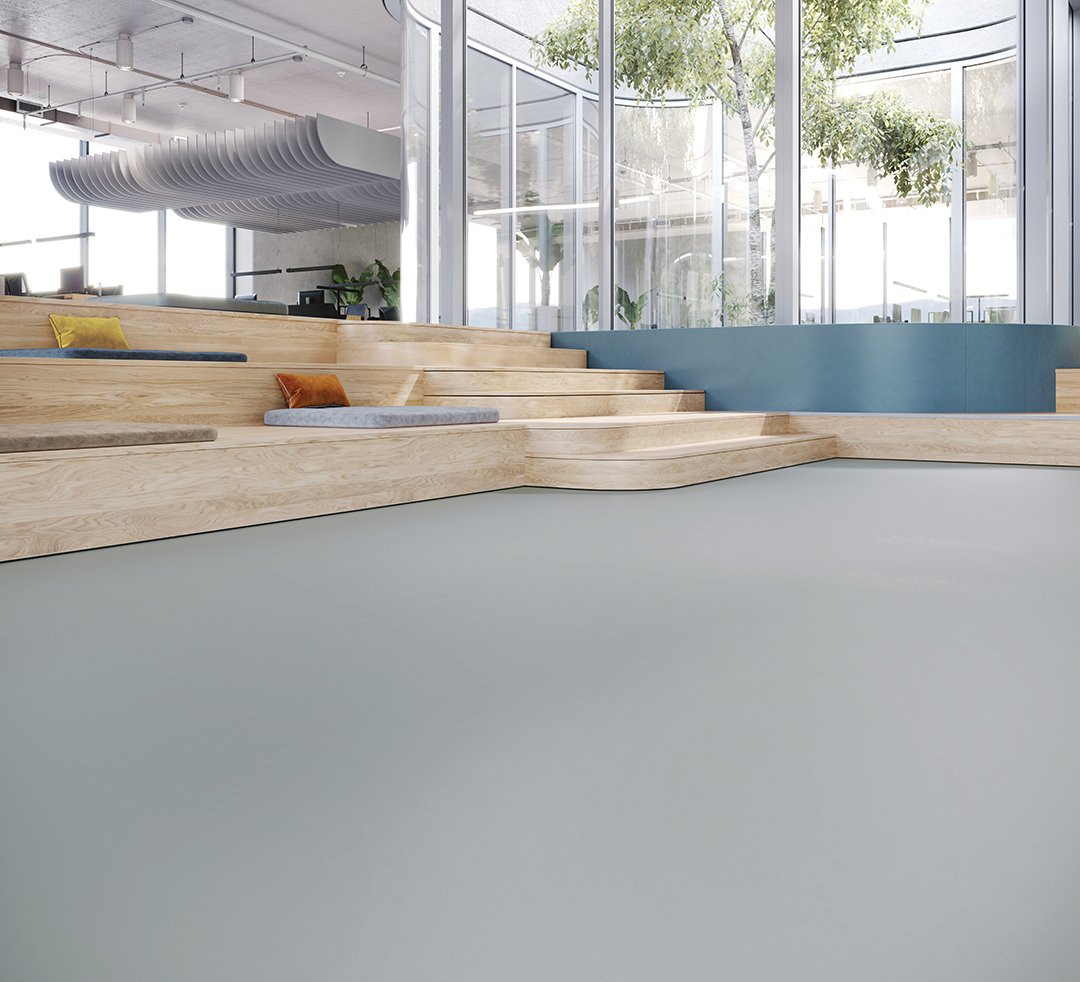Today’s linoleum isn’t your grandma’s floor covering. There are definitive reasons why it can be a viable choice for commercial customers in a broad variety of environments, especially in a new form – liquid linoleum.
For more than a decade, liquid linoleum has been performing in demanding commercial environments. With a wide array of performance and sustainable benefits, customers have been enjoying all of the quality solutions this flooring type provides.
Like any product, there are positives and negatives that should be weighed before making a choice. Let’s examine the product itself as well as the new choices offered by Mannington Commercial.
Duracryl created Liquid Linoleum in the Netherlands originally. Once established over in Europe, they decided to bring the product (Corques Liquid Linoleum) to the U.S. market.
After a few years of establishing some jobs in the U.S. through end users, specifiers, designers, etc., Duracryl decided that the best way to gain more business was to find a company that was established in the Healthcare segment with a brand that would make sense and align with their own history and culture. That’s how Duracryl found Mannington. Paul Clark from Duracryl and I worked together in past lives. He brought the product to me and we developed it into Legato. The rest is history.
What is liquid linoleum?
Let’s start with the basics. Liquid linoleum is a poured flooring made of six basic ingredients: cork, linseed oil, vegetable oil, limestone and a coloring agent. In Mannington’s new product, Legato, a Quantum Guard Elite urethane is applied to create a topical performance surface.
To install liquid linoleum, the ingredients are shipped to the location then mixed on-site in a timed process and troweled onto the floor. This affords multiple benefits, including a seamless finished floor.
Where can liquid linoleum be used?
A seamless flooring product without harmful VOCs that’s sustainable? It would seem to be a perfect choice for a wide variety of environments – and it is. Almost any space that specifically needs to be easy to clean with less possibility of harboring germs is a fit. Healthcare spaces, education facilities, government facilities and retail spaces are all examples of viable applications.
As an example, like sheet linoleum, a liquid linoleum floor isn’t the best choice for a warehouse where forklifts regularly run back and forth. However, the product has shown to successfully withstand normal rolling loads such as imaging equipment in healthcare facilities.
You Might Like: The Top Benefits of Legato Liquid Linoleum
Legato Collection - GR346
What are the benefits of a poured floor?
Almost every commercial flooring product has pros and cons. It’s important to look at the full picture of every product you spec, as the considerations for each space can differ. Liquid linoleum can be a great solution for your consideration, so let’s run down some of the many positives:
· Legato is a more sustainable solution. It includes an EPD and HPD, is Declare Red List Free and may contribute to LEED credits.
· The product is PVC free and VOC free, with no plasticizers, no formaldehydes, no chlorine, and no heavy metals. This can be a major upside, especially for customers with environmental accountability as part of their mission.
· The Legato line offers 54 colors in the product palette.
· The product has a “memory,” so indentation isn’t a problem. For example, if a heavy chair is placed on the floor and creates dimples, it will bounce back. While it won’t stand up to the weight of heavy industrial machinery, it does accommodate other equipment such as that used in healthcare facilities.
· Price is always a factor in selecting flooring. Liquid linoleum might appear more expensive on paper, but it can be a better value once all the other factors are taken into consideration. Installation labor costs can vary widely by location, but through Mannington, there’s no adhesives required, which can quickly add to the installed cost of other flooring options.
· Sheet linoleum is manufactured much like vinyl flooring on a press then cut into rolls which can result in waste because of necessary cuts. With liquid linoleum, you only use as much as you need.
· With an adequate crew, a large floor can be installed quickly with no need for glue, heat welds or flash cove. And, if a container isn’t opened, it can be used for the next job so there’s no waste.
What are the drawbacks?
Time is a big factor for designers, project managers and specifiers depending on the needs of the project. Some customers don’t want to allocate the days necessary for proper installation.
If the product is going into a new construction project, that’s usually not an issue, but a facility that’s already in use might object to shutting down a space for three to five days – especially if that space generates revenue, such as an operating room. Legato also requires a larger budget when you factor in higher installation costs.
Installation also requires experts who understand the product and the process, which can be more costly than installing traditional sheet linoleum.
Legato Collection - B413
How is liquid linoleum installed?
Preparing the subfloor is literally the foundation of ensuring a quality installation. For commercial properties, the flooring is often placed over concrete substrates. If the floor had any existing floor covering, the product and adhesive would need to be completely removed and the surface sanded until smooth and level in preparation for the primer. It’s also necessary to use a moisture mitigation system for each install.
Installation for a one-color floor is a two-day process to install with a day to fully cure. The product is mixed and poured on day one, then allowed to set for at least eight hours. The next day, installers do a thorough examination to ensure there are no defects, then a Quantum Guard finish is rolled on as a top coat. By day three, the floor is set and ready for foot traffic. It’s possible to do a floor with two or three colors but each time a color is added, it adds a day to the installation process.
What happens when a customer wants to change the flooring? There are a couple of options. Because liquid linoleum is bonded to a primer on the substrate, it’s easy to score the floor and simply pull it up and completely recycle it. Or, if the floor is in good shape and the customer just wants a different look, it’s possible to go over the existing surface with a leveler and pour another layer of liquid linoleum on top, which means there’s no waste. However, given the average thickness of the floor, this can only be done once.
What’s the bottom line?
Liquid linoleum might not be the first choice for designers or specifiers – not yet. But, the myriad benefits from sustainability to its comparable value to the hygienic solution to cleanliness issues, make it worth while to be considered for a variety of locations.
To learn about the Legato Collection watch the video below.
Want to keep reading more about Legato Liquid Linoleum Flooring?
We have a guide for you! Dive into the pro's and con's of a liquid linoleum floor, see how to install and repair Legato, weigh the top ten benefits and explore the frequently asked questions about this flooring product. Enjoy! 👇



